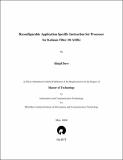Please use this identifier to cite or link to this item:
http://drsr.daiict.ac.in//handle/123456789/132Full metadata record
| DC Field | Value | Language |
|---|---|---|
| dc.contributor.advisor | Bhatt, Amit | |
| dc.contributor.advisor | Vijaykumar, C. | |
| dc.contributor.advisor | Chakka, Vijaykumar | |
| dc.contributor.author | Dave, Kinjal | |
| dc.date.accessioned | 2017-06-10T14:37:05Z | |
| dc.date.available | 2017-06-10T14:37:05Z | |
| dc.date.issued | 2006 | |
| dc.identifier.citation | Dave, Kinjal (2006). Reconfigurable application specific instruction set processor for kalman filter (R-ASIK). Dhirubhai Ambani Institute of Information and Communication Technology, x, 81 p. (Acc.No: T00095) | |
| dc.identifier.uri | http://drsr.daiict.ac.in/handle/123456789/132 | |
| dc.description.abstract | Kalman filter is one of the most important signal processing algorithms used in many tracking applications. The main challenges for hardware implementation of Kalman filter include compute intensiveness O (n3) of the algorithm, numerical sensitivity to rounding errors and huge data I/O requirements. These challenges severely limit its use in high speed, real-time tracking applications that require very small iteration times. This work proposes a novel reconfigurable architecture for the VLSI implementation of Kalman filter, coined as Reconfigurable Application Specific Instruction Set Processor (ASIP) for Kalman Filter (R-ASIK). The R-ASIK architecture is based on the concept of ‘Reconfigurable Systolic Arrays (RSA)’ and provides a real-time implementation by computing a single iteration of the filter in just 15(n + 1) clock cycles using only n(n+1) processing elements, where n is the order of the filter. Other unique features of R-ASIK include increased robustness to rounding errors and resolving the data I/O problem. Reconfigurable feature in R-ASIK architecture provides the flexibility of mapping filters of different sizes ‘n’, on the same architecture. This is a unique feature and does not exist in current literature. A novel architecture to compute transpose of a matrix in only one clock cycle is also presented. The VLSI implementation of R-ASIK was done in three steps namely, modelling the R-ASIK using Verilog HDL, logic synthesis and physical synthesis. The implementation methodology presented for logic and physical synthesis resulted in efficient implementation of R-ASIK in silicon. R-ASIK was mapped to four target technologies (180,130, 90 and 65 nm) and the synthesis results are analyzed. Physical synthesis of R-ASIK was carried out for 180 nm technology. R-ASIK works at 50 MHz clock, which is quite high for a data path intensive algorithm like Kalman filter. | |
| dc.publisher | Dhirubhai Ambani Institute of Information and Communication Technology | |
| dc.subject | Electric filters | |
| dc.subject | Filters | |
| dc.subject | Digital electronic | |
| dc.subject | Kalman filtering | |
| dc.classification.ddc | 621.3815324 DAV | |
| dc.title | Reconfigurable application specific instruction set processor for kalman filter (R-ASIK) | |
| dc.type | Dissertation | |
| dc.degree | M. Tech | |
| dc.student.id | 200411034 | |
| dc.accession.number | T00095 | |
| Appears in Collections: | M Tech Dissertations | |
Files in This Item:
| File | Description | Size | Format | |
|---|---|---|---|---|
| 200411034.pdf Restricted Access | 1.37 MB | Adobe PDF |  View/Open Request a copy |
Items in DSpace are protected by copyright, with all rights reserved, unless otherwise indicated.
